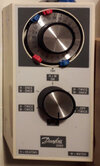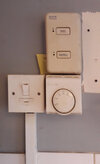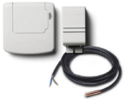Yes, you would be in the same situation.What if I were to ditch the nest and get the hive would I be in the same situation?
The wireless stat, is how your cylinder is 'speaking' to your controller.Also what is currently speaking to my cylinder anyway? Surely it's wired right down to the programmer at the boiler currently as the little receiver at the tank is wireless and only has a wire sitting on the side of the tank for the temperature?
You appear to have an 'S plan' system.
Typically this includes a wired tank stat and room thermostat.
The Honeywell RF2 pack 3, simplifies this setup, by making it wireless.
From this...
To this...
Any change of controller will require a new tank stat and wiring going back to the wiring centre.
I'm afraid I don't know of such a device, others may - but it wouldn't speak to the nest. It would connect into the wiring centre.Another question, is there something I could potentially get to replace/upgrade the wireless device at the tank that could speak to the nest?
As we've suggested, with this workaround; Nest controls the hot water on and off times, whilst the Honeywell only maintains the overheat cut-off, without the need for any additional work on the cylinder, or additional wiring through new floors.
Yes...So basically I'd have to keep the honeywell programmer and run new wires to connect the heatlink that comes with the nest?
The other appropriate connections...having terminal 3 (HW ON) of the ST, feed terminal 5 (HW common) of Nest. The wire that was in ST9420C 3, would go into Nest terminal 6 (HW call-for-heat) - the Nest would then have timing authority, when the ST9420C retains over temperature cut-off.
The other connections to Nest, would be made appropriately, with only a Live bridge required to terminal 2 (C/H COM).
Feed the Heatlink with a Live, Neutral and Earth connection.
The wire that was in ST terminal 4 (C/H ON) would go into Heatlink terminal 3.
Last edited:




